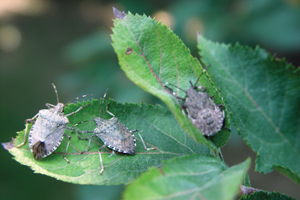From Asia: Sustainable Insights into Stink Bugs
 |
|
Adult brown marmorated stink bugs. Source: Gary Bernon, USDA APHIS, Bugwood.org. |
A collection of articles originally published in China, Japan, and Korea and translated with American Farm Bill funds has yielded a bounty of insights into sustainable agriculture practices used in Asia against the brown marmorated stink bug (BMSB), a serious agricultural pest.
The stink bug, Halyomorpha halys (Stål), is a voracious eater that damages fruit, vegetable, and ornamental crops in North America. The insect uses over 170 plants for food and reproduction, and threatens an estimated $21 billion worth of crops in the United States alone. Researchers in the BMSB community, including those with the BMSB Working Group and the BMSB Specialty Crop Research Initiative (SCRI) Coordinated Agricultural Project, have tapped into the collection of articles. The BMSB Working Group is funded by the Northeastern IPM Center, which also directs outreach for the national BMSB SCRI research project.
One tactic against the pest used in Asia: cover each fruit on the tree with a paper bag. (American trade publications such as Fruit Grower News have discussed this approach.) According to USDA Agricultural Research Service (ARS) scientist Tracy Leskey, in Korea some fruit is grown to a huge size, perhaps three pounds, and the entire fruit is served as a dessert. Therefore, it makes economic sense to protect the fruit from BMSB and the fruit-piercing moth (“that huge moth is like a vampire because it flies at night and sucks out the juices out of ripe fruit,” Leskey commented.) Bagging represents a behavioral control that can be implemented and prevents insects from making contact with the growing fruit. Leskey mentioned it makes sense in smaller orchards where laborers can easily administer the bagging. The technique may be more challenging but still could be useful in larger settings.
In August of 2013 a team of researchers, including Leskey, led by Doo-Hyung Lee of USDA ARS, published a review paper on the biology, ecology, and management of BMSB in China, Japan, and Korea. The paper cites 100 articles, a significant selection of the 216 publications on BMSB known to exist from Asia.
According to the translation, one researcher from Japan wrote, “Stink bugs that migrate to apple orchards are often difficult to detect because they often hide in gaps between leaves and fruit in trees. Therefore, branches and the trunk need to be shaken just forcefully enough so that fruit does not fall from the tree in order to check for the presence of pests.”
Chinese researchers wrote about their experiments with light traps for monitoring and management. They mention tactics such as removing egg masses, capturing stink bugs physically, using a buffer zone plant around cash crops, bagging fruit, and creating an encouraging environment for parasitic wasps such as the Trissolcus species.
Other researchers, also from China, wrote that the stick-beating method causes bugs to drop, then pesticides can be applied on the ground under the tree. They believe that bagging fruit is not productive; they say it impedes growth of good quality fruit and does little to stop BMSB. They also mention that spraying equipment disturbs BMSB and causes them to fly away. The bugs return after spraying is done.
Scientists in Japan wrote that they trapped more bugs facing the river where cool breezes circulated than on the mountainside. They also said that spraying insecticide at entry points in dwellings helped stop stink bugs. Spraying DEET repellant at entry points also worked well.
A team of researchers in China wrote that saprophytic bacteria cause fruit flesh to turn light brown and the fruit falls easily from the tree. They believe bagging fruit reduces H. halys damage.
The male-produced aggregation pheromone (methyl (E,E,Z)-2,4,6-decatrienoate) of the brown-winged green bug, Plautia stali Scott, is commonly used to attract H. halys to traps in the late season. Also: timing of insecticide applications was recommended early in the morning when bugs were less active.
“The translated Asian literature has taught us much about natural enemies and physical methods we can consider for managing BMSB,” Leskey said. “We’ve learned a lot about the bug’s biology and what types of crops it attacks. Not every tactic used in Asian systems will be effective in ours, but the research points us toward where we should be heading and away from tactics we can rule out.”
— by CHRIS GONZALES
StopBMSB.org provides information about our team's efforts to control brown marmorated stink bug (BMSB), through funds provided by the USDA's Specialty Crop Research Initiative. If republishing our news, please acknowledge the source ("From StopBMSB.org") along with a link to our website.
